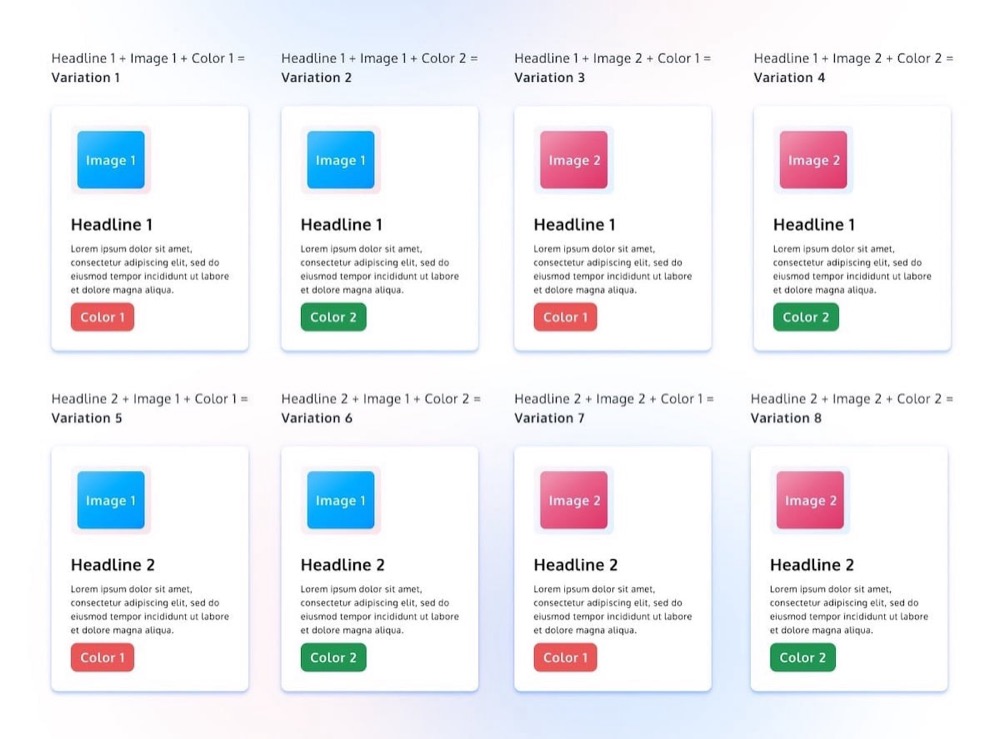What Is Multivariate Testing? Our Complete 2025 Guide
Isn’t multivariate testing just several A/B tests running at the same time?
No. That’s one of the most popular myths about MVT. It’s much more nuanced than that.
Unlike A/B tests that compare one change at a time, multivariate tests evaluate multiple variables and their combinations simultaneously. It’s an efficient way for high-traffic sites to find the combination of changes that performs the best.
Knowing when to use MVT over A/B testing, how it differs from A/B/n testing, and what it takes to run a reliable test can help you optimize smarter and scale your experimentation with confidence.
What Is Multivariate Testing?
Multivariate testing is a technique for testing multiple variables on a webpage in different combinations to find out which combination produces the best results.
Here’s how CRO manager Shiva Manjunath puts it:
“It’s important to understand that multi-variate doesn’t mean multiple VARIATIONS. You can have one variation with multiple variables, or multiple variations with single variables, or a mish mosh of them.”
Unlike A/B testing, or split testing, which compares just one change at a time, multivariate testing allows you to experiment with several changes simultaneously and measure how they perform together. The purpose isn’t only to find the best version of an individual element but also to understand how changes to multiple elements interact to influence user behavior.
Multivariate testing is similar to A/B/n testing because you are testing two or more variations against the control. The difference is:
- A/B/n tests are univariable, testing one element per test
- MVT tests explore combinations of multiple elements at the same time
Example of a Multivariate Test
Let’s say you want to test two different headlines, two images, and two button colors on your homepage. A multivariate test would generate every possible combination of those variables.
That setup results in eight page variations that mix headlines, images, and CTA button colors. The goal is to discover which combination delivers the best conversion rate.
You can also test more than two variations per element—it’s common to test three, four, or more variations at once. But keep in mind: The more combinations you test, the more traffic you’ll need to reach statistical significance.
MVT Is Not the Same as Concurrent Testing
Concurrent testing runs multiple, unrelated experiments on the same audience, aiming to answer different questions at once. This approach can muddle insights and skew data.
In contrast, MVT keeps the hypothesis focused. You’re still asking one unified question—just testing several combinations to answer it.
When Should You Use Multivariate Testing? (And When You Shouldn’t)
Multivariate testing makes the most sense when:
- You want to understand how multiple changes work together.
- Your site or campaign receives a significant amount of traffic.
- You’re refining a high-impact area—like a landing page or pricing section—where different elements need to align.
You may want to hold off on MVT if:
- You’re unsure which specific elements matter most—start with A/B to identify priorities.
- You don’t have enough traffic to support statistical significance across all test variations.
- You need to move fast or test one idea at a time—A/B testing is better when you’re optimizing quickly or focusing on a single element.
Multivariate Testing vs. A/B Testing: How to Choose
When deciding between multivariate testing and A/B testing, the right choice largely depends on your testing goals and the complexity of the changes you’re looking to test.
| Criteria | A/B Testing | Multivariate Testing |
|||||||||||||||
|---|---|---|---|---|---|---|---|---|---|---|---|---|---|---|---|---|---|
| When to use | Simple changes (e.g., testing a single element) | Testing multiple changes at once (e.g., headlines + images + buttons) | |||||||||||||||
| Best for | Low-traffic sites or single-variable tests | High-traffic sites needing to optimize multiple elements simultaneously | |||||||||||||||
| Setup complexity | Relatively easy to set up | More complex setup; requires testing different variations | |||||||||||||||
| Traffic requirements | Lower traffic needed for statistical significance | Requires high traffic to achieve reliable results | |||||||||||||||
| Data granularity | Measures one variable at a time | Identifies the best combination of elements from multiple variations | |||||||||||||||
| Example | Testing two versions of a headline | Testing combinations of headline, image, and call-to-action button on a homepage |
If you’re testing a single element or tackling low conversion rates, A/B testing is a smart place to start. For example, Convert partner agency SplitBase ran a headline A/B test and saw a 27% lift from just one targeted change.
For optimizing multiple elements together, multivariate testing offers deeper insight. A strong example comes from HawkHost, which tested combinations of hero images, subheadings, and CTAs. One combo led to a 204% boost in sales.
Convert supports both A/B and multivariate tests with advanced targeting and segmentation, so you avoid traffic dilution and get trustworthy results.
Benefits of Multivariate Testing
Multivariate testing offers the following key advantages:
- Removes guesswork from UI decisions: Test multiple elements together to understand how design combinations affect user behavior, replacing assumptions with real data.
- Gathers more insight from fewer tests: Combine several changes into one experiment, saving time and traffic.
- Speeds up optimization cycles: Identify top-performing combinations faster to implement meaningful changes without delays.
- Uses traffic and resources efficiently: Maximize test coverage without increasing workload—ideal for high-traffic sites or busy teams.
- Identifies which variant drives the biggest gains: Pinpoint the combinations that boost conversions, not just individual element performance.
- Tests complex changes in one go: Experiment with page layout, copy, and visuals simultaneously to refine multifaceted user experiences.
Is Multivariate Testing Still Relevant in a Privacy-First World?
With Google Optimize shutting down and third-party cookies disappearing, it’s fair to ask: Is multivariate testing still viable?
The answer is yes—if you’re using tools that prioritize privacy and compliance.
Modern MVT platforms like Convert are built for a privacy-first web. With features including server-side testing, consent-aware targeting, and GA4-compatible integrations, you will protect user trust when running meaningful experiments.
Convert supports:
- First-party data use aligned with GDPR and CCPA
- Consent mode, so tests run only with user opt-in
- Edge and server-side delivery for speed and compliance
- GA4 support to keep your analytics pipeline intact
Multivariate testing hasn’t disappeared—it’s adapting. And in today’s environment, using a privacy-compliant testing platform is the only way forward.
How to Run a Multivariate Test (Without Wasting Traffic)
Running multivariate tests can drive significant insights, but only if they’re structured well and managed with care. Follow these seven steps to get accurate results without wasting traffic:
- Define a focused hypothesis: Start with a clear question to keep your test grounded, such as: “Will changing the headline, image, and CTA together increase free trial signups?” Use our hypothesis generator to get started.
- Choose high-impact elements to test: Select two to three elements that directly influence conversions, such as headlines, hero images, CTAs, or supporting copy.
- Let Convert build the combinations: Using a full factorial test design, Convert automatically creates all possible combinations. For example, 2 headlines × 2 images × 2 buttons = 8 unique variants.
- Create variations using Convert’s editor: Make content changes without code using the visual editor, or switch to JavaScript mode to build logic-driven or dynamic variations. Use our guide on how to create a multivariate test in Convert.
- Set smart audience targeting rules: Avoid traffic dilution by targeting the right users. Convert lets you segment by location, device type, returning vs. new users, UTM parameters, and more.
- Run quality checks before launch: Preview every combination, confirm that all goals fire correctly, and ensure scripts don’t interfere with tracking. This step protects your data and user experience.
- Monitor performance with Live Logs: Use Live Logs to track which combinations are being served, which users qualify, and how your test behaves in real time.
💡 Looking for the best tool? Popular A/B testing tools include VWO, Optimizely, AB Tasty, and Google Optimize 360 alternatives.
Convert Experiences stands out for privacy-first teams. With server-side testing, GA4 support, consent-aware targeting, and both visual and developer modes, it offers flexibility without sacrificing speed or compliance.
Still exploring? Check out this full list of the best multivariate testing tools.
How to Calculate Sample Size for a Multivariate Test
Calculating the right sample size is critical to ensuring statistically significant results. In general, a larger sample size means more reliable results.
Use Convert’s free calculator to estimate how many website visitors you’ll need, based on your variations, baseline conversion rate, and desired statistical power.
Make sure each variation gets enough traffic to produce meaningful data. If you have less traffic, test fewer variations or focus on high-impact elements.
When Should You Stop Your MVT Test?
Stopping a test too early sometimes leads to false winners and wasted effort. Don’t end a multivariate test until all of these are true:
- Each variant has enough data: Let the test run long enough so every combination collects reliable insights.
- You’ve completed at least one full cycle: Run through 30–60 days to capture typical sales, traffic, or marketing campaign patterns.
- You’ve reached statistical significance: Wait for a 95% confidence level and consistent results before going live.
Avoid cutting traffic to underperforming variants too soon. Early dips don’t always mean failure, and shifting traffic mid-test can distort your findings.
Use Convert’s Live Logs and dashboards to monitor tests and make data-driven decisions.
Learn more: A/B Testing Statistical Significance: How and When to End a Test.
Multivariate Testing for Conversion Optimization
Multivariate testing is a key methodology in conversion rate optimization (CRO) to improve usability and support data-driven growth decisions.
Align Test Goals with Business Outcomes
To make the most of multivariate testing, start with a clear business goal. Whether you’re aiming to increase conversions or reduce drop-offs, the page elements you test should align with that outcome.
With Convert, you can link each experiment to performance metrics—including click-through rates, bounce rate, and conversion rate—to ensure your test results support more than surface-level changes.
Interpret Results Across Combinations
Multivariate testing doesn’t just show what works—it also shows which combinations of elements work best together. It helps you learn how different designs or messages influence user behavior across segments.
Convert’s segmentation tools enable you to break down results by device, region, or audience type to see how variations perform in different contexts.
Connecting Insights to Broader Decisions
Insights from MVT do more than improve a single page. When patterns emerge—such as which headlines consistently perform well or which layout boosts usability—they guide larger strategy decisions.
Convert helps you organize tests by project or client, making it easy to apply those learnings across campaigns, funnels, or brands.
Run Quality Assurance Checks
Even well-designed tests can fail if a variation breaks layout, functionality, or tracking. These issues skew results and may harm user experience. A quick QA check before launch ensures accurate data and smooth testing.
Check this QA process before going live:
- Variation load: Make sure all variations display correctly on every device and browser.
- Tracking integrity: Confirm tracking codes are working and analytics tools are capturing data.
- Segmentation settings: Verify that you’re targeting the right audience (e.g., geo, device).
- Statistical readiness: Ensure your test is set to measure significance before drawing conclusions.
Use Convert’s preview tools, traffic simulation, and Live Logs to catch issues early—before they affect performance or results.
👉 Want to dive deeper? Download our QA checklist for A/B and multivariate testing to ensure every test runs clean, accurate, and error-free.
Common Multivariate Testing Challenges (And How to Overcome Them)
Multivariate testing will uncover valuable insights, but only when planned and executed carefully. Here are common pitfalls and what to do instead.
Spreading Traffic Too Thin
The more combinations you test, the more your traffic gets divided. Without enough sessions per variant, you risk inconclusive results.
How to solve it: Test fewer elements, use high-traffic pages, and focus on major changes over minor tweaks.
Missing Interaction Insights
MVT isn’t just about finding the top variant—it’s also about how elements affect each other. Skipping deeper analysis can lead to missed opportunities.
How to solve it: Use Convert’s segmentation tools, review second-best combinations, and add behavioral context through heatmaps or recordings.
Overcomplicating the Test
Testing too many things at once without a clear goal creates noise instead of insight.
How to solve it: Limit each test to two to three variables tied to one objective. Avoid combining unrelated changes and always start with a clear hypothesis.
Skipping QA Across Combinations
A single broken variation can invalidate your results or damage user experience.
How to solve it: Preview every combination, simulate targeting and goal logic, and check Live Logs to confirm everything’s working.
Testing Without Strategic Alignment
If your test doesn’t support a larger goal, even strong results may go unused.
How to solve it: Tie each test to a business objective, document all findings, and use Convert’s organization tools to scale insights across clients or teams.
Ready to Run Your First Multivariate Test?
Multivariate testing helps you understand how elements work together to improve conversions. With the right traffic and a clear hypothesis, you can test smarter and make confident, data-driven decisions.
Convert Experiences gives you everything you need to run advanced tests—visual editor, JavaScript control, segmentation, and Live Logs—while maintaining traffic control or privacy compliance.
Sign up for Convert to launch your first multivariate test—built for fast, ethical, high-impact experimentation.
Written By
Uwemedimo Usa, Maheen Kanwal

Edited By
Carmen Apostu



